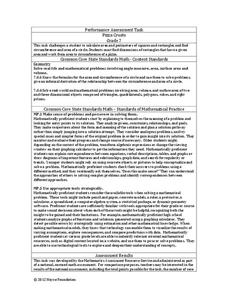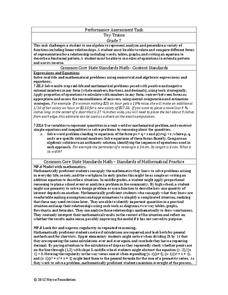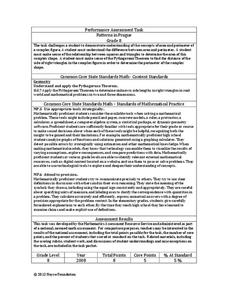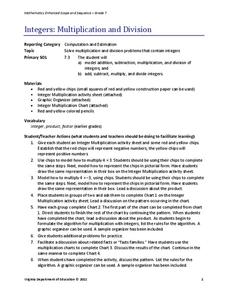Inside Mathematics
Graphs (2006)
When told to describe a line, do your pupils list its color, length, and which side is high or low? Use a worksheet that engages scholars to properly label line graphs. It then requests two applied reasoning answers.
Noyce Foundation
Pizza Crusts
Enough stuffed crust to go around. Pupils calculate the area and perimeter of a variety of pizza shapes, including rectangular and circular. Individuals design rectangular pizzas with a given area to maximize the amount of crust and do...
Curated OER
Show What You Know: Estimate: Enrichment
In this estimating sums worksheet, learners write a greater than or less than sign to solve the addition sentences. Students first use estimation to help them compare the numbers.
Curated OER
Higher Order Taylor Polynomials
In this polynomial worksheet, students approximate values of linearly using the tangent line. They use first and second-degree polynomials to find the equation of a line tangent to a graph. Students explore Taylor's Theorem. This...
Noyce Foundation
Toy Trains
Scholars identify and continue the numerical pattern for the number of wheels on a train. Using the established pattern and its inverse, they determine whether a number of wheels is possible. Pupils finish...
Noyce Foundation
Sewing
Sew up your unit on operations with decimals using this assessment task. Young mathematicians use given rules to determine the amount of fabric they need to sew a pair of pants. They must also fill in a partially complete bill for...
Inside Mathematics
Hopewell Geometry
The Hopewell people of the central Ohio Valley used right triangles in the construction of earthworks. Pupils use the Pythagorean Theorem to determine missing dimensions of right triangles used by the Hopewell people. The assessment task...
Curated OER
Dividing By 2 and 5
Third graders divide by 2 and 5. In this math instructional activity, 3rd graders label the parts of a division sentence. Students solve division sentences using multiplication.
Noyce Foundation
Parallelogram
Parallelograms are pairs of triangles all the way around. Pupils measure to determine the area and perimeter of a parallelogram. They then find the area of the tirangles formed by drawing a diagonal of the parallelogram and compare their...
Inside Mathematics
Rugs
The class braids irrational numbers, Pythagoras, and perimeter together. The mini-assessment requires scholars to use irrational numbers and the Pythagorean Theorem to find perimeters of rugs. The rugs are rectangular, triangular,...
Inside Mathematics
Rhombuses
Just what does it take to show two rhombuses are similar? The assessment task asks pupils to develop an argument to show that given quadrilaterals are rhombuses. Class members also use their knowledge of similar triangles to show two...
Curated OER
Estimating and Measuring Amounts
Third graders explore measurement. In this estimation and measurement lesson, 3rd graders examine visual examples using standard units to measure length. Students also practice solving problems that their instructors model.
Curated OER
Numerical Analysis: Machine Representation of Numbers
In this machine representation of a number worksheet, high schoolers explore definitions such as floating-point, round-off error, binary representation of a number, mantissa, and sign bit. They identify significant digits and determine...
Noyce Foundation
Ducklings
The class gets their mean and median all in a row with an assessment task that uses a population of ducklings to work with data displays and measures of central tendency. Pupils create a frequency chart and calculate the mean and median....
EngageNY
Applications of the Pythagorean Theorem
Begin seeing the world through the lens of geometry! Use the 19th installment in a 25-part module to apply the Pythagorean Theorem to solve real-world problems. Individuals sketch situations resulting in right triangles such as the...
EngageNY
Dividing Fractions and Mixed Numbers
Class members discover how to extend division to fractions to mixed numbers. Individuals first review how to convert mixed numbers to improper fractions and then apply division strategies learned in previous lessons. A memory game...
EngageNY
Dividing Multi-Digit Numbers Using the Algorithm
Scholars learn to divide multi-digit numbers using the standard algorithm in the 14th installment in a module of 21 parts. They get plenty of practice with the algorithm by completing a worksheet.
Curated OER
Population: Logistically Speaking
In this population worksheet, students read word problems relating to population growth. They write the problem as a differential equation, create models and graphs of the solution. This three-page worksheet contains 10 multi-step...
Curated OER
Estimate Differences
In this estimation activity, students solve a total of 6 word problems that involve rounding to a given place value and estimating.
Curated OER
Errors in Riemann Sums
In this Riemann Sums worksheet, students use the Riemann Sums method to approximate the area under the curves. This two-page worksheet contains three problems.
Curated OER
Riemann Sums and Error Stacks
In this Riemann sums worksheet, students use accumulation to find the estimate for the area of a given shape. Students use Riemann sums to estimate the area under the curves and error stacks to bound the error of their approximation....
Curated OER
Finding Roots and Newton's Method
In this roots worksheet, students identify the local maxima and minima for a function. Students find the roots of the function using roots and Newton's Method of approximation. This three-page worksheet contains examples, explanations...
Inside Mathematics
Patterns in Prague
Designers in Prague are not diagonally challenged. The mini-assessment provides a complex pattern made from blocks. Individuals use the pattern to find the area and perimeter of the design. To find the perimeter, they use the Pythagorean...
Virginia Department of Education
Integers: Multiplication and Division
Rules are meant to be broken ... but not integer multiplication and division rules. Learners use chips to model integer multiplication and division. The results of the activity help them develop integer rules for these operations.























